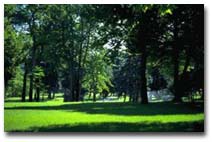|
Lawns
An Expensive Anachronism As the most severe drought of the century continues to hold the Southeast in its grip, traditional lawns and gardens are dying of thirst. But homeowners who have replaced much of their traditional landscaping with local native plants and minimal to no lawn space are escaping the frustration and disappointment faced by their neighbors. "Native plant landscapes will survive even under stressful drought conditions," said Jean White, assistant naturalist at the National Wildlife Federation (NWF). "They are able to adapt to the irregular rainfall patterns that Mother Nature imposes." There are more than 20 million acres of lawn - 32,000 square miles - in the U.S., covering more land than any single crop. In urban areas, lawn irrigation accounts for as much as 30 percent of water consumption on the East Coast, with the average lawn using 10,000 gallons of water over the course of a summer. Coupled with intense water needs, the high doses of fertilizers used on any lawns are environmentally destructive and make them unsuitable habitat for most wildlife. The average suburban lawn is deluged with 10 times the quantity of chemical pesticides per acre as farmland. Replacing lawns with local native plants reduces water needs, provides a landscape that can prosper despite rainfall and temperature fluctuations, does not depend on chemical pesticides and fertilizer, and benefits wildlife populations as well, notes NWF... .
|

